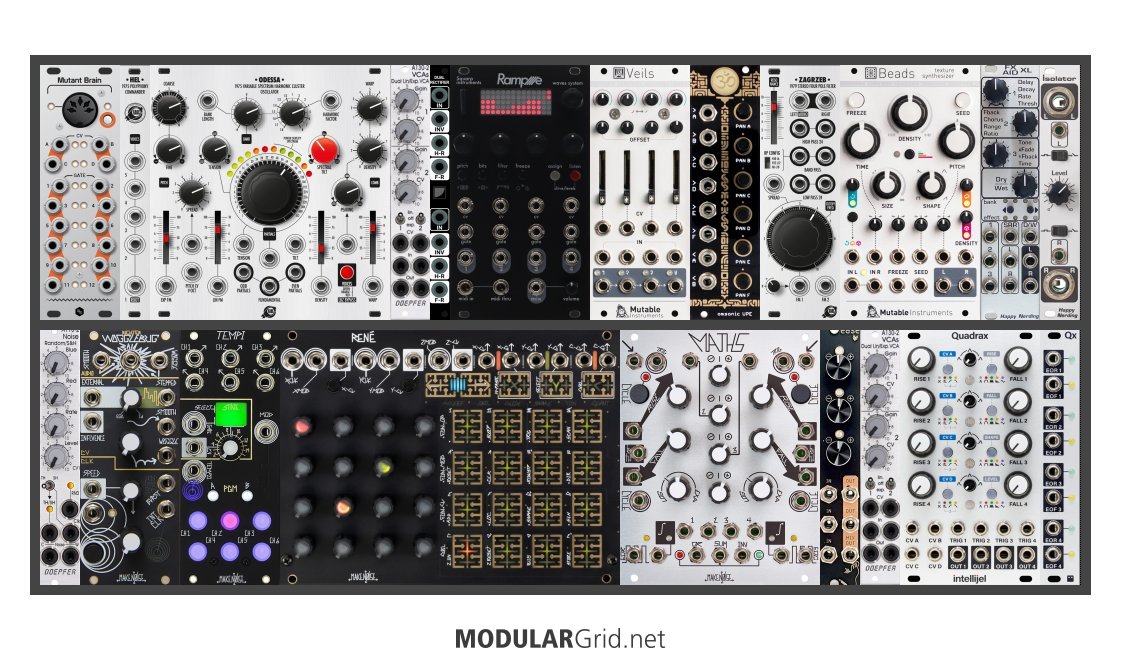You're not going to manage an Iridium/Quantum in modular. Polyphony in modular generally results in huge systems, as you need a massive amount of repeated modules in groups...for starters. Same VCOs, VCFs, VCAs, LFOs, etc etc. Oh, and it'll have you ripping your hair out while programming it. But then, this isn't really what modular is about; you want to build something in Eurorack that is capable of stuff that only a modular can do, just like a Waldorf synth does what THEY do.
The Mantis is a good starting choice, as it can easily be expanded with a second Mantis + the link brackets. Also, the current capacity of the P/S is beefy. But the build above is just not going to work...there's too many really big modules in there in space that could be better used by smaller modules. That way, you can have some elaborate capabilities that, right now, this build isn't capable of.
Lessee here........OK...hmm, not bad:

OK...so, I coupled a sampler together with a VERY complex harmonic oscillator. Yeah, just one...and given what it's capable of, one is all you need! Let's have a look...
TOP: OK...I improved on the MIDI interface by putting in one of Hexinverter's Mutant Brain interfaces. 12 gates, four CVs, with a nice bit of flexibility. Then the Xaoc Odessa oscillator, plus a Hel, the four-voice poly expander...so you can have some polyphony until you hit the VCF, which gives you paraphony. A pair of VCAs is after this, with switchable response. Then that little black sliver is a pair of rectifier-type waveshapers, so that if you want to "nasty up" the Odessa, just run its VCAs through that. Then the multichannel sampler, which here is a Squarp Rampler...this saves space, and it makes the sampler a lot easier to deal with since you only have four outs. After that, there's a Veils which gives each Rampler channel its own VCA. Then to sum all of the VCAs down to stereo, there's an Omsonic UPE, which is a unity gain mixer with panning across six channels. With the audio signal now in stereo, I went with a Xaoc Zagrzeb, which is a stereo multimode VCF with all modes "hot" and in stereo. This filter also allows some weird things, such as putting a HPF on the left and an LPF on the right so that sounds can "migrate" across the stereo field, plus a lot of other potential mayhem. Beads goes in after that, then a Happy Nerding FX Aid XL for typical processing, then this feeds a Happy Nerding Isolator, which transformer-isolates your outputs so that you can avoid ground loops...plus you can hit it hard with the audio signal to get a nice bit of transformer saturation.
BOTTOM: A Doepfer noise/random/S&H module starts this off, then I swapped the Benjolin for a Wogglebug. Similar sort of idea, but more space-sensible. Next, the Make Noise Tempi/Rene mkii combo provides a similar sequencer environment to the Erica, but with a LOT more timing tricks as those two modules are designed to be used together, unlocking some hidden bits that a backplane connector between them uses. Then Maths, followed by a Tenderfoot triple attenuverter/mixer for CV and modulation signals. Another dual VCA like in the top row is after that to provide level control over modulation signals. And last, an Intellijel Quadrax/Qx combo lets you generate basic envelopes...or complex composite ones. Or even more if you crosslink them with the Maths.
That's a better use of space, I think. By doing this, it opened up more space for more functionality without having to resort to having itty-bitty controls for your main modules. And going with the Rampler will be easier to deal with than the Bitbox, which would require quite a bit more in utilities, etc to use to its best advantage. And the Odessa only seems to just be one oscillator...which it is and also isn't. Xaoc stuff is generally very feature-rich, and this is no exception. And hey...I came up with a sum that's only $50 off of your own, but this'll do WAY more for your money.
